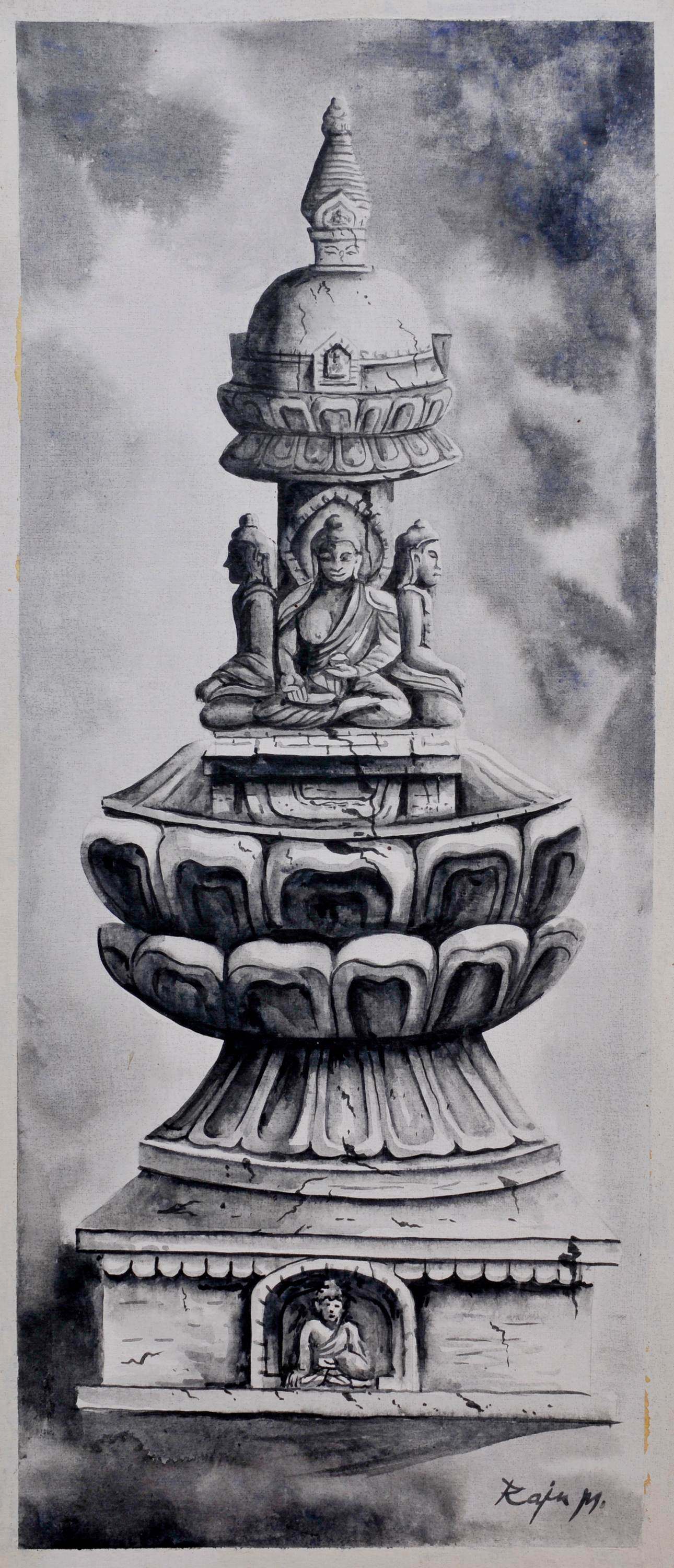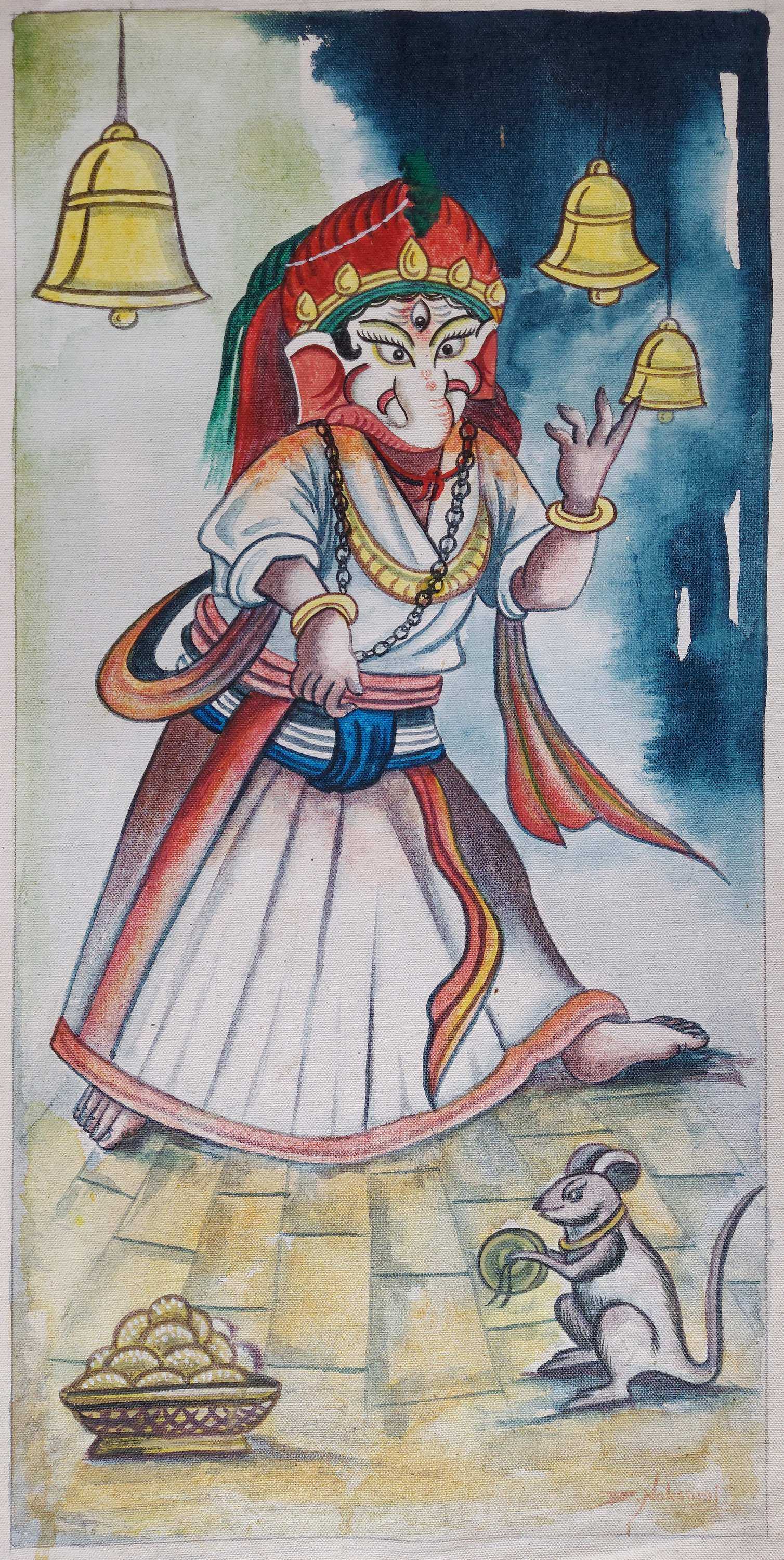
Code
HCS28292
Weight
300 gm / 0.66 lbs
Size
Height
76cm (30") Width
35cm (14") Material
Cotton Canvas, and oil paint
Availability
Available

Safe Payment
We accept Paypal, Money Transfer, Bank Transfer
Confidence
Protection covers your purchase and personal data.
Worldwide Delivery
We ship Worldwide, except Russia.Shipping cost US$25.2 for upto 0.5 kgs

Hotline
Talk to help line for your question on 9841267335Stupa : Brief Introduction
A stupa is a mound-like structure containing Buddhist relics, typically the remains of Buddha, used by Buddhists as a place of worship. The stupa is the oldest Buddhist religious monument and was originally only a simple mound of mud or clay to cover supposed relics of the Buddha (cetiya). After the parinirvana of the Buddha, his remains were cremated and the ashes divided and buried under eight stupas with two further stupas encasing the urn and the embers. Little is known about these early stupas, particularly since it has not been possible to identify the original ten monuments. However, some later stupas, such as at Sarnath and Sanchi, seem to be embellishments of earlier mounds.
The shape of the stupa represents the Buddha, crowned, and sitting in meditation posture on a lion throne. His crown is the top of the spire; his head is the square at the spire's base; his body is the vase shape; his legs are the four steps of the lower terrace, and the base is his throne. Read More . . .
A stupa is a mound-like structure containing Buddhist relics, typically the remains of Buddha, used by Buddhists as a place of worship. The stupa is the oldest Buddhist religious monument and was originally only a simple mound of mud or clay to cover supposed relics of the Buddha (cetiya). After the parinirvana of the Buddha, his remains were cremated and the ashes divided and buried under eight stupas with two further stupas encasing the urn and the embers. Little is known about these early stupas, particularly since it has not been possible to identify the original ten monuments. However, some later stupas, such as at Sarnath and Sanchi, seem to be embellishments of earlier mounds.
The shape of the stupa represents the Buddha, crowned, and sitting in meditation posture on a lion throne. His crown is the top of the spire; his head is the square at the spire's base; his body is the vase shape; his legs are the four steps of the lower terrace, and the base is his throne. Read More . . .
About Oil Painting :
A Nepali oil painting is a work of art created using oil paints on canvas or another surface. Nepali oil paintings often depict scenes and subjects that are significant to Nepali culture and heritage, such as mountains, landscapes, Newari life, Kathmandu, temples, and stupas.
Mountains: Nepal is known for its stunning mountain landscapes, including the Himalayas and Mount Everest. Nepali oil paintings often feature these majestic peaks, which are painted in great detail to capture their beauty and grandeur.
Mountains: Nepal is known for its stunning mountain landscapes, including the Himalayas and Mount Everest. Nepali oil paintings often feature these majestic peaks, which are painted in great detail to capture their beauty and grandeur.
Landscape: The Nepali landscape is diverse and varied, ranging from lush green valleys to arid highlands. Nepali oil paintings may depict these landscapes in a variety of styles, from realistic depictions to more abstract interpretations.
Newari Life: The Newari people are an ethnic group native to the Kathmandu Valley in Nepal. Nepali oil paintings may depict aspects of Newari life, such as traditional festivals, ceremonies, and cultural practices.
Kathmandu: The capital city of Nepal, Kathmandu is a vibrant and colorful city with a rich cultural heritage. Nepali oil paintings may feature iconic landmarks and buildings in Kathmandu, such as Durbar Square, Swayambhunath Stupa, and Boudhanath Stupa.
Temples and stupas: Nepal is home to numerous temples and stupas, which are important religious and cultural sites. Nepali oil paintings may depict these sites in great detail, capturing their intricate architecture and decorative elements.
Overall, Nepali oil paintings are a beautiful and vibrant representation of Nepali culture and heritage, capturing the essence of this rich and diverse country. They are treasured works of art that carry deep meaning and significance for those who create and admire them.
Newari Life: The Newari people are an ethnic group native to the Kathmandu Valley in Nepal. Nepali oil paintings may depict aspects of Newari life, such as traditional festivals, ceremonies, and cultural practices.
Kathmandu: The capital city of Nepal, Kathmandu is a vibrant and colorful city with a rich cultural heritage. Nepali oil paintings may feature iconic landmarks and buildings in Kathmandu, such as Durbar Square, Swayambhunath Stupa, and Boudhanath Stupa.
Temples and stupas: Nepal is home to numerous temples and stupas, which are important religious and cultural sites. Nepali oil paintings may depict these sites in great detail, capturing their intricate architecture and decorative elements.
Overall, Nepali oil paintings are a beautiful and vibrant representation of Nepali culture and heritage, capturing the essence of this rich and diverse country. They are treasured works of art that carry deep meaning and significance for those who create and admire them.


![Buddhist Stupa [oil Colour Painting], Bhaktapur Art](https://handicraftseller.com/uploads/pics/product/thumb/2023/02/28292.jpg)
 of Kumari,
of Kumari,  of Dancing Ganesh
of Dancing Ganesh